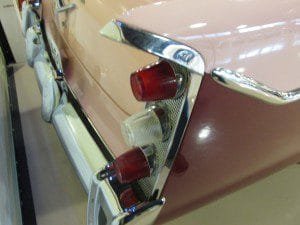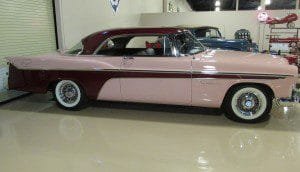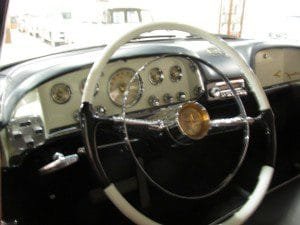The first DeSoto Firedome model was introduced in 1952 as a full size automobile built by the DeSoto Division of the Chrysler Corporation. The DeSoto Firedome also introduced a new V-8 Hemi engine replacing the straight six.

The Beginning of DeSoto / Filling A Gap
De Soto automobiles were first introduced with the 1929 model. De Soto cars were produced by Chrysler and the De Soto line was utilized to fill in the gap between the Chrysler and Dodge brands. De Soto’s chief competitors were GM’s Buick and Oldsmobile.
De Soto’s creation actually came about in 1928, the same year Chrysler acquired Dodge and also the same year that Chrysler added the lower cost Plymouth brand. This was all just a short four years after the Chrysler brand itself was introduced.
The first De Soto’s on the market had 3.2 liter six cylinder engines and were priced slightly below the Chrysler brand and above the Plymouth brand.

The 1956 DeSoto Firedome Seville
The 1956 DeSoto Firedome Seville has a sleek design with the customary tail fins seen so much on cars in the mid to late 1950’s. The instrument panel was of aircraft design and easily was one of the most imaginative dashboards of the 1950’s.
The DeSoto Firedomes had the Virgil Exner design touch, this one in a smart two tone paint scheme, which made a mark for itself throughout the Chrysler Corporation brands during the 50’s. Many attribute the tail fin designs of the 50’s seen across numerous brands to Chrysler designer Virgil Exner.
Another design touch which entered the picture in 1956 was the “Christmas Tree” tail light assembly. Along with the new tail fins in 1956 the DeSoto Firedome tail lights gave the automobile a rocket like rear end. Also in 56 the toothy grille was replaced with a mesh one and helped give the car a more dynamic appearance compared to 1955.
DeSoto offered four models of the Firedome in 1956. These included a convertible, sedan, wagon and hardtop coupe. The car’s success was a combination of smart design, both exterior and interior, and DeSoto’s reputation for engineering excellence. The V-8 Hemi offered in the 1956 DeSoto is a good example of DeSoto and Chrysler engineering of the period.

The 1956 DeSoto Firedome models sold very well. In fact, the models sold so well that they outsold Chryslers during that model year. This was the first time in DeSoto history that the brand outsold it’s parent Chrysler brand. Added to this triumph was DeSoto serving as the Indy 500 Pace Car that year.
1956 DeSoto Firedome Specifications
The 1956 DeSoto Firedome Seville came with a 330 cubic inch V-8 with a two barrel carburetor delivering 230 horsepower. DeSoto Fireflite models had the same engine but with four barrel carburetors that put out 255 horses.
Two transmissions were offered with this 1956 DeSoto. One was a two speed Powerflite push button automatic.1956 was the first year of the push button automatic. The other transmission offered was a Borg Warner manual overdrive.
The car’s overall outside length was 220.9 inches, a width of 78.3 inches and a wheelbase of 126.0 inches.
Interestingly enough, DeSoto offered both seat belts and a padded instrument panel as extra options.

DeSoto’s New 12 Volt Electrical System
During the mid 1950’s many automakers switched from 6 volts to 12 volts for their electrical systems. Actually the Dodge brothers used a 12 volt system in the late teens into the 1920’s which phased back into 6 volts later.
1956 was the year that DeSoto made the change. As a symbol of this new power source DeSoto offered a power antenna in 1956. In addition to that Dodge also offered a power front seat and a Highway Hi-Fi record player.
From 1956 to 1960, DeSoto’s Last Five Years
As mentioned above, DeSoto had a banner sales year in 1956. Unfortunately, after that the division ran into competitive trouble. When 1961 arrived the DeSoto line was discontinued.
There are many opinions about what happened to DeSoto. Many feel that DeSoto was the Oldsmobile of the 1950’s. While Olds sailed through the 1950’s and beyond, their trouble occurred when the financial downturn of 2008 hit and the brand was considered somewhat redundant.
Did Chrysler fully support DeSoto when times got tough? Maybe, maybe not. The same could be said about GM when Oldsmobile was sacrificed to automotive history. What is known is that changing markets and demographics can make two brands redundant. When this happens a large automaker begins looking for ways to cut costs.
See the additional AutoMuseumOnline articles on the links below…
1956 Olds Rocket 88 Convertible

1956 DeSoto Firedome Collector Cars
The highest classic car prices for 1956 DeSoto’s is found with the two door convertible. The 1956 DeSoto is a milestone automobile in the sense that the tail fin and tail light assembly plus the new mesh grille and 12 volt electrical system with it’s accessories differentiated it from previous models.
The DeSoto Seville hardtop shown in this article ranks second in collector value. This car’s price range as of this writing and depending on condition and originality would be from the $20,000 to $60,000 range. As with many 1950’s restored automobiles, mint museum quality vehicles can be in the six figures depending on the exact model. The Powerflite automatic transmission DeSotos with operating electrical accessories will be valued higher than those without.
A good reference book on the DeSoto and Plymouth automobiles is the Illustrated Plymouth and Desoto Buyer’s Guide by Jim Benjaminson.
(Article and photos copyright 2014 AutoMuseumOnline)